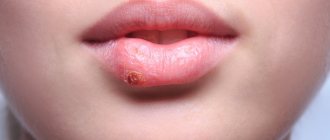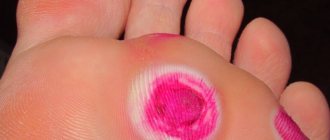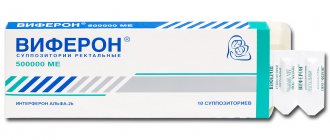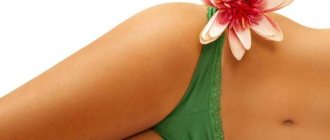Herpes
is a viral disease. One of the most well-known manifestations of a herpes infection is small, clear, painful blisters on the lips. Previously, in such a case they said “a cold on the lip popped up”, now they more often talk about “herpes on the lip”.
However, the family of herpes viruses is quite large. There are several types of herpes virus that can infect the human body. The most studied types are:
- herpes simplex virus type 1
(HSV-1). It is he who is responsible for pimples on the lip. HSV-1 primarily affects the mucous membranes of the lips, oral cavity and nasopharynx. Herpetic rashes can also appear within the nasolabial triangle (in particular, on the wings of the nose), less often on the cheeks and other parts of the face. Recently, HSV-1 quite often becomes the cause of herpetic lesions of the genital area, where it is introduced through oral sex; - herpes simplex virus type 2 (HSV-2) – genital herpes
. Main manifestations: redness, the appearance in the area of redness of bubbles filled with liquid, tending to merge, the appearance of erosions and crusts at the site of the bubbles, itching, headache and muscle pain, increased urination; - chickenpox virus
(varicella) is a type 3 herpes virus. In people who have already had chickenpox, this type of virus causes herpes zoster. Therefore, this type of herpes is also called Varicella-Zoster; - Epstein-Barr virus
(Epstein-Barr viral infection - EBVI) is a type 4 herpes virus. It is the causative agent of mononucleosis, causes malignant diseases of lymphoid tissue, and is considered the cause of chronic fatigue syndrome; - cytomegalovirus
– herpes virus type 5. The virus poses a threat to children during fetal development. May affect internal organs.
Causes of herpes on the face, treatment, prevention
They say about herpes: “small but vicious.”
After all, the size of the lesion is small, but subjectively it is very disturbing. Many of us have asked the question: “Which doctor should we contact to treat herpes on the lips in order to get rid of the disease once and for all?” – because this disease can recur more than once, appearing at the most inopportune moment. Herpes is a viral disease that manifests itself in small infiltrates that develop into vesicles (cavities with liquid). The symptoms of herpes simplex infection are too typical not to recognize the painful blisters that torment a person for several days. Theoretically, pathology can develop on any part of the skin of the human body. But most often the virus “loves” to infect:
- the mucous membrane of the lips is the area most often “visited” by the pathogen;
- the border of the mucous membrane of the lips and skin around the mouth;
- conjunctiva;
- cornea;
- external genitalia (both men and women).
Unfortunately, injections or pills have not yet been invented to prevent herpes. Therefore, you should study the information about it well in order to successfully fight the disease at the first signs of manifestation, and, if possible, prevent it. You should especially be wary of herpes on the lips of women in early pregnancy. Its presence means that a viral agent has entered the body of the expectant mother, which can affect the intrauterine development of the fetus.
Acne (acne, blackheads, pimples)
Most often this term is used in relation to acne (blackheads, comedones) and pimples. Acne is the result of a malfunction of the sebaceous glands, which is inflammatory in nature. Due to the blockage of the follicles of the pilosebaceous ducts with a “plug” consisting of dead skin flakes and sebum, the skin becomes an ideal environment for the development of bacteria, which cause inflammation and the appearance of acne. Acne can appear on the face, neck, back and other parts of the body in different ways.
- Black dots. In this case, access to sebum is hampered by “plugs” of hard horny scales. Their outer part becomes dark due to dust. Typically, blackheads appear on the forehead, nose and chin, as well as on the chest and back.
- Blackheads are white in color. They are also called millets. These are pinpoint nodules the size of grains that occur due to stretching of the glands and retention of sebum. Such acne usually appears in the eyelid area and on the cheekbones.
- Acne vulgaris. These are the so-called common acne on the face, which occurs due to chronic inflammation of the sebaceous glands. Most often they appear in adolescents during puberty.
- Pustular acne. They usually have red purulent caps and appear when the epidermis is damaged. The appearance of pustules is preceded by squeezing out the acne.
- Conglobate acne. These skin rashes are round in shape and are associated with staphylococcal bacillus. This kind of acne that occurs on the side of the cheeks, neck and back is the most dangerous. After removal and healing of the inflamed nodes, scars remain.
- Medicinal acne. This is the result of the use of various medications that cause allergies. This type of acne appears on the body in the form of ulcers or red spots.
- Phlegmonous acne. This is a tumor formed as a result of damage to the sebaceous glands. Acne grows together and takes the form of abscesses or ulcers. After their removal, scars form in this place.
Main reasons
Experts identify several main types of acne, depending on the causes of their occurrence. First of all, these are endogenous (arising due to internal causes) and exogenous (arising due to external causes) acne. Let's look at the causes of acne.
- Changes in hormonal balance. This is the most common cause of acne in adolescents during puberty. Enlarged sebaceous glands lead to increased sebum production. In girls and women, changes in hormonal balance can cause acne during menstrual cycles, and may also be associated with taking birth control medications.
- Decreased immunity and gastrointestinal dysfunction. The ability for bacteria to parasitize and actively multiply on the skin is provided, among other things, by reduced immunity. Healthy intestinal microflora is 70% of the immune system, which is an obstacle to infection that causes the formation of new acne. In addition, a healthy immune system ensures effective healing of existing acne.
- Stress. Acne can appear in those people who constantly experience severe stressful situations, and can also be a consequence of chronic overwork. Stress during exams, worries about relationships with friends and parents can really have a big impact on the health of young skin. In this case, the best advice would be to worry less and ensure daily skin care.
- Use of comedogenic cosmetics. Some cosmetics - creams, lotions and blushes - contain lanolin, sulfur, petroleum jelly, paraffin, mineral and vegetable oils, as well as red pigments. These ingredients can cause acne. As a rule, many people use special cosmetics to disguise them (powders, foundation), which aggravates the course of the disease. A so-called vicious circle is formed, which complicates acne removal.
- Improper skin care. In many cases, the cause of the spread of acne is improper skin care. As a result of self-removal of dying skin cells and self-medication, for example, widespread squeezing out of blackheads and pustules, the epidermis is damaged, and the infection receives further spread.
- Environmental factors. Changes in climatic conditions also play a significant role in the intensity of acne and the area affected. Many people believe that winter is the worst time for acne due to harsh weather conditions that lead to dry, flaky skin. However, in winter, using additional moisturizers can only worsen the rash.
Pimples are elements not only of acne, but also of other skin diseases (rosacea, folliculitis, etc.). They are treated differently. To get rid of acne, you need to know the diagnosis and form of the skin condition. There are several main factors that trigger the mechanism of acne:
- Excessive production of sebum by the sebaceous glands;
- Reproduction of propionic acne bacteria (Propionibacterium acnes). These bacteria, along with others, live in the tubules of the sebaceous glands in all people without exception, even in completely healthy ones. And only when their number increases for various reasons, the skin begins to become covered with pimples and acne develops;
- Follicular hyperkeratosis. This medical term hides the process of excessive formation of horny skin cups. After all, both sebum and keratinized particles of the epidermis, which clog the follicle, are involved in the formation of pimples and comedones.
Factors causing the disease
The herpes virus may be present in our body, but not manifest itself. The disease begins to develop under certain factors - the virus is activated. The reasons for the appearance of herpes on the face are the same as the reasons for the appearance of herpetic blisters on other areas of the skin:
- hypothermia;
- violation of work and rest schedules;
- hypovitaminosis (regardless of the time of year);
- fatigue;
- chronic disorders of the immune system.
For relapses, it is also important that a periodically ill person does not attach importance to herpes and lets everything take its course, each time expecting that “it will go away on its own.”
Complex therapy, pain relief
A patient suffering from a neuralgic disorder must be treated with painkillers. Doctors do not recommend enduring pain steadfastly - this can provoke an increased reaction and the development of a chronic syndrome.
Painkillers should be taken until the discomfort disappears. To relieve the syndrome, the following groups of drugs are prescribed:
- NPS – “Ketorolac”, the drug “Aspirin”, the drug “Ketorolac”, “Ibuprofen”.
- Antidepressants (tricyclic) - Clomipramine, medication Imizin.
- Anticonvulsant medications - Pregabalin or Gabapentin.
- Blockades using novocaine, electrical stimulation of injured nerves.
- Potent analgesics that can reduce the intensity of the syndrome are Tramadol.
- Local medications that contain capsaicin - “Mataren Plus” ointment.
NPS are used at the height of the disease. To alleviate the painful syndrome, a neurologist may prescribe:
- "Nimesulide", simple "Aspirin";
- "Ibuprofen" or "Desketoprofen";
- "Ketoprofen".
NPS allow you to numb the problem area and relieve inflammation during the period when neuralgia begins to progress. The drugs are taken orally in the form of a suspension, capsules or syrup. To relieve herpetic syndrome, topical agents with hot pepper extract are prescribed along with medications of this group. Lidocaine-based gel provides effective pain relief.
After recovery, postherpetic neuralgia is treated with novocaine blockades, drugs of the NPS group, using other methods at the discretion of the doctor and taking into account the individual characteristics of the body.
Symptoms of herpes simplex infection
There are few signs of herpes, but they are all very characteristic. Therefore, difficulties in differential diagnosis almost never arise.
The main symptoms of infection with herpes simplex, which is the most common form of herpetic lesions, are as follows:
- painful tissue swelling appears in the affected area;
- after 1-2 days it transforms into a denser infiltrate;
- the infiltrate turns into a bubble with liquid;
- the blister bursts and a painful ulcer forms in its place;
- the ulceration dries out and is covered with a new layer of epithelium - the wound heals.
The way lips look after herpes is the same as after any other skin disease: the swelling disappears, but the ulcer cannot heal for some time. It is covered with a yellowish film that constantly “peels off” from the wound surface, thereby exposing the wound and delaying the process of epithelial regeneration at the site of the lesion.
What to do for warning?
The best preventative measures to prevent this disease and its manifestations will be regular measures to strengthen the immune system. These include:
- Hardening. Dousing with ice water, Russian bath and sauna with herbal teas, walking barefoot on the grass in the summer, contrast shower.
- Autohemotherapy. A method in which blood is taken from a vein and injected into the buttock according to a special scheme. First, increase the dose and then gradually decrease it.
- The use of well-known strengthening folk remedies: ginseng, echinacea, licorice root, rose hips, herbal teas.
Diagnosis of the disease
Herpetic blisters look so characteristic that they cannot be confused with the morphological signs of other diseases - neither with an abscess, nor with specific ulcerations, nor with an allergic rash. In the vast majority of cases, the diagnosis is made on the basis of clinical manifestations.
A blood test for antibodies to the herpes simplex virus is an indirect method of identifying the pathogen in the body. It can be used if the body’s reactivity (the intensity of the response to external harmful agents) is low, and the infiltrate does not develop into characteristic blisters, which raises the question among clinicians: is it herpes?
Herpes simplex, which is manifested purely by a rash on the face, should be distinguished from herpes type 6, which is characterized not only by a rash, but also by a sharp increase in temperature.
Etiology
Herpes viruses contain double-stranded DNA and have a glyco-lipoprotein envelope. The sizes of viral particles are from 120 to 220 nm.
Today, 8 types of herpes viruses that have been identified in humans have been described:
- two types of herpes simplex virus (HSV-1, HSV-2),
- varicella zoster virus (VZV or HHV-3),
- Epstein-Barr virus (EBV or HHV-4),
- cytomegalovirus (CMV or HHV-5), HHV-6, HHV-7, HHV-8.
Based on the biological properties of viruses, 3 subfamilies of herpes viruses have been formed: (alpha herpes viruses, beta herpes viruses and gamma herpes viruses). A-herpesviruses include HSV-1, HSV-2, VZV.
Betaherpesviruses include CMV, HHV-6, HHV-7. They, as a rule, multiply slowly in cells, cause an increase in the affected cells (cytomegaly), are capable of persistence, mainly in the salivary glands and kidneys, and can cause congenital infections. Gammaherpesviruses include EBV and HHV-8.
How to get rid of constantly appearing herpes on the lips
Herpes is the competence of a dermatovenerologist. Only a qualified doctor can tell you how to treat different types of herpes, taking into account:
- characteristics of the immune system of a particular person;
- the degree of weakening of the body at the time of the disease;
- tendency to relapse.
Medicines that are used for herpes on the lips:
- antiviral drugs in the form of ointments and gels (acyclovir, herperax);
- immunomodulators that increase the body's resistance (cycloferon, arbidol);
- at the stage of herpetic ulcers - softening balms with Vaseline and allantoin.
Many people wonder how to quickly cure colds on the lips in adults in 1 day (based on analogies with the influenza virus, colds on the lips mean a herpetic rash). Answer: if the process has developed beyond the infiltration stage, no way. The vesicle must go the entire way from its appearance to self-opening, the formation of a wound surface and its healing, and this will take an average of 2-3-4 days. An ointment for colds on the lips that would speed up this process has not yet been invented.
But if you just feel characteristic pain and notice swelling, physiotherapy methods (UHF, microwave) can contribute to the reverse development of the infiltrate, and it does not transform into an ugly bubble that spoils the anatomical aesthetics.
Medicine for herpes on the lips of a child should be used strictly according to the doctor’s instructions - regardless of whether this concerns immunomodulators or antiviral drugs.
You can read more about what treatment methods are used for herpes on our clinic’s website
Oral medications
Herpes is a viral infection. You can get rid of its symptoms with the help of medications taken orally. Oral medications block the activation of viral cells, due to which the external manifestations of herpes go away.
Most often, dermatologists prescribe drugs based on acyclovir - these are tablets of the same name, Zovirax, Ciclovir and others. The course of treatment depends on the course of the disease, usually it does not exceed 7 days. Symptoms such as swelling, burning and itching disappear after 1-2 days.
Immunomodulators are rarely prescribed as primary treatment and are usually combined with antiviral medications.
- Cycloferon, the full course of treatment lasts a month.
- Amiksin, course duration varies from 10 days to a month.
- Likopid, the course of treatment lasts 6-10 days, after which a break is taken for 3 days.
Immunomodulators relieve swelling by activating natural protective functions. The body begins to fight herpes on its own and after a few days the unpleasant symptoms of the disease begin to subside.
Before you start dealing with swelling, you should consult a dermatologist or therapist. The doctor will confirm the diagnosis and prescribe an effective treatment regimen.
Author of the article
Dermatologist, doctor of the highest category, 31 years of experience.
Prevention
The secrets of prevention, how to get rid of constantly appearing herpes on the lips and reduce the possibility of its recurrence, are quite simple:
- according to all the rules, cure fresh herpetic rashes using antiviral and drying ointments;
- strengthen the immune system with the help of immunomodulators, vitamin therapy;
- Do not touch shared utensils with your lips without treating them additionally.
If your partner has herpes, personal relationships also need to be adjusted to preventive measures - in other words, avoid kissing (not only on the affected lips, but also on intimate places where genital herpes can develop. Even if the herpes “only popped up” on the lips – it is possible that the pathogen may be on the mucous membrane of the genital organs, although their morphological changes have not yet been observed).
Knowing how the herpes virus type 6 is transmitted in children (and it is transmitted through breastfeeding and through saliva, most often from the mother), it can be prevented as follows:
- if you suspect you have a disease, do not kiss your child;
- do not give water to your child from your own mug;
- stop breastfeeding;
- Do not “clean” a baby’s dropped pacifier or pacifier in a quick way by sucking it in your mouth (an archaic method that, nevertheless, for some reason has taken root among mothers).
Related services: Consultation with a dermatologist Dermatovenereology
Why is herpes infection dangerous?
If the rashes are located on the surface, then complex therapy makes it possible to prevent the development of secondary pathologies. When inflammation affects the deep layers, negative consequences are possible:
- clouding of the cornea;
- blurred vision;
- hemorrhages;
- gradual death of tissues, their detachment;
- glaucoma, cataract;
- loss of vision.
Important! The development of dangerous pathologies is not observed from primary herpes under the eye, but in the absence of adequate treatment, the virus will gradually penetrate into the deeper layers of the organ, which will lead to serious consequences.
What to do for warning?
The best preventative measures to prevent this disease and its manifestations will be regular measures to strengthen the immune system. These include:
- Hardening. Dousing with ice water, Russian bath and sauna with herbal teas, walking barefoot on the grass in the summer, contrast shower.
- Autohemotherapy. A method in which blood is taken from a vein and injected into the buttock according to a special scheme. First, increase the dose and then gradually decrease it.
- The use of well-known strengthening folk remedies: ginseng, echinacea, licorice root, rose hips, herbal teas.
What to do for warning?
The best preventative measures to prevent this disease and its manifestations will be regular measures to strengthen the immune system. These include:
- Hardening. Dousing with ice water, Russian bath and sauna with herbal teas, walking barefoot on the grass in the summer, contrast shower.
- Autohemotherapy. A method in which blood is taken from a vein and injected into the buttock according to a special scheme. First, increase the dose and then gradually decrease it.
- The use of well-known strengthening folk remedies: ginseng, echinacea, licorice root, rose hips, herbal teas.
Acyclovir-based drugs
Acyclovir and derivatives of this drug (Zovirax, Virolex and others) are used in the treatment of all forms of herpes, including herpes zoster. The medicine affects only the virus, introducing itself into the DNA structure of the pathogen and preventing the spread of infection to healthy tissue. A drug with this effect is available in the form of tablets and ointments.
It is recommended to use Acyclovir when the pathology manifests itself in the form of itching and burning. Due to the fact that the drug suppresses the activity of the virus, the swelling quickly subsides.
"Acyclovir" in tablet form is used in severe cases when the disease becomes generalized. In case of local damage, ointments based on this substance are prescribed. Patients with immunodeficiency should consult a doctor before use. Frequent treatment of affected areas of the face reduces the effectiveness of Acyclovir.











